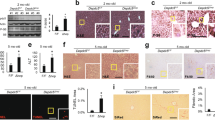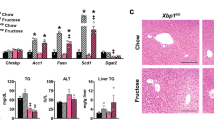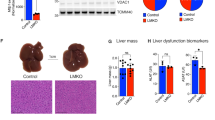Abstract
As the ultimate electron acceptor in oxidative phosphorylation, oxygen plays a critical role in metabolism. When oxygen levels drop, heterodimeric hypoxia-inducible factor (Hif) transcription factors become active and facilitate adaptation to hypoxia. Hif regulation by oxygen requires the protein von Hippel-Lindau (pVhl) and pVhl disruption results in constitutive Hif activation. The liver is a critical organ for metabolic homeostasis, and Vhl inactivation in hepatocytes results in a Hif-dependent shortening in life span. While albumin-Cre;VhlF/F mice develop hepatic steatosis and impaired fatty acid oxidation, the variable penetrance and unpredictable life expectancy has made the cause of death elusive. Using a system in which Vhl is acutely disrupted and a combination of ex vivo liver perfusion studies and in vivo oxygen measurements, we demonstrate that Vhl is essential for mitochondrial respiration in vivo. Adenovirus-Cre mediated acute Vhl disruption in the liver caused death within days. Deprived of pVhl, livers accumulated tryglicerides and circulating ketone and glucose levels dropped. The phenotype was reminiscent of inborn defects in fatty acid oxidation and of fasted PPARα-deficient mice and while death was unaffected by pharmacologic PPARα activation, it was delayed by glucose administration. Ex vivo liver perfusion analyses and acylcarnitine profiles showed mitochondrial impairment and a profound inhibition of liver ketone and glucose production. By contrast, other mitochondrial functions, such as ureagenesis, were unaffected. Oxygen consumption studies revealed a marked suppression of mitochondrial respiration, which, as determined by magnetic resonance oximetry in live mice, was accompanied by a corresponding increase in liver pO2. Importantly, simultaneous inactivation of Hif-1β suppressed liver steatosis and rescued the mice from death. These data demonstrate that constitutive Hif activation in mice is sufficient to suppress mitochondrial respiration in vivo and that no other pathway exists in the liver that can allow oxygen utilization when Hif is active precluding thereby metabolic collapse.
This is a preview of subscription content, access via your institution
Access options
Subscribe to this journal
Receive 50 print issues and online access
$259.00 per year
only $5.18 per issue
Buy this article
- Purchase on Springer Link
- Instant access to full article PDF
Prices may be subject to local taxes which are calculated during checkout







Similar content being viewed by others
References
Belanger A, Luo Z, Vincent K, Akita G, Cheng S, Gregory R et al. (2007). Hypoxia-inducible factor 1 mediates hypoxia-induced cardiomyocyte lipid accumulation by reducing the DNA binding activity of peroxisome proliferator-activated receptor alpha/retinoid X receptor. Biochem Biophys Res Commun 364: 567–572.
Bergemeyer H, Bernt H, Schmidt F, Stork H . (1974). Methods in Enzymatic Analysis. Academic Press: London, pp 1196–1201.
Burgess S, Hausler N, Merritt M, Jeffrey F, Storey C, Milde A et al. (2004). Impaired tricarboxylic acid cycle activity in mouse livers lacking cytosolic phosphoenolpyruvate carboxykinase. J Biol Chem 279: 48941–48949.
Burgess S, He T, Yan Z, Lindner J, Sherry A, Malloy C et al. (2007). Cytosolic phosphoenolpyruvate carboxykinase does not solely control the rate of hepatic gluconeogenesis in the intact mouse liver. Cell Metab 5: 313–320.
Burgess S, Leone T, Wende A, Croce M, Chen Z, Sherry A et al. (2006). Diminished hepatic gluconeogenesis via defects in tricarboxylic acid cycle flux in peroxisome proliferator-activated receptor gamma coactivator-1alpha (PGC-1alpha)-deficient mice. J Biol Chem 281: 19000–19008.
Chan S, Zhang Y, Hemann C, Mahoney C, Zweier J, Loscalzo J . (2009). MicroRNA-210 controls mitochondrial metabolism during hypoxia by repressing the iron-sulfur cluster assembly proteins ISCU1/2. Cell Metab 10: 273–284.
Chen S, Sanford C, Sun J, Choi V, Van Dyke T, Samulski R et al. (2010). VHL and PTEN loss coordinate to promote mouse liver vascular lesions. Angiogenesis 13: 59–69.
Chow T, Youssef Y, Lianidou E, Romaschin A, Honey R, Stewart R et al. (2010). Differential expression profiling of microRNAs and their potential involvement in renal cell carcinoma pathogenesis. Clin Biochem 43: 150–158.
Ciana P, Biserni A, Tatangelo L, Tiveron C, Sciarroni A, Ottobrini L et al. (2007). A novel peroxisome proliferator-activated receptor responsive element-luciferase reporter mouse reveals gender specificity of peroxisome proliferator-activated receptor activity in liver. Mol Endocrinol 21: 388–400.
Cockman M, Masson N, Mole D, Jaakkola P, Chang G, Clifford S et al. (2000). Hypoxia inducible factor-alpha binding and ubiquitylation by the von Hippel-Lindau tumor suppressor protein. J Biol Chem 275: 25733–25741.
Dohm GL, Huston RL, Askew EW, Weiser PC . (1972). Effects of exercise on activity of heart and muscle mitochondria. Am J Physiol 223: 783–787.
Folch J, Lees M, Sloane Stanley G . (1957). A simple method for the isolation and purification of total lipides from animal tissues. J Biol Chem 226: 497–509.
Gebhard R, Clayman R, Prigge W, Figenshau R, Staley N, Reesey C et al. (1987). Abnormal cholesterol metabolism in renal clear cell carcinoma. J Lipid Res 28: 1177–1184.
Gnarra J, Tory K, Weng Y, Schmidt L, Wei M, Li H et al. (1994). Mutations of the VHL tumour suppressor gene in renal carcinoma. Nat Genet 7: 85–90.
Gnarra J, Ward J, Porter F, Wagner J, Devor D, Grinberg A et al. (1997). Defective placental vasculogenesis causes embryonic lethality in VHL-deficient mice. Proc Natl Acad Sci USA 94: 9102–9107.
Haase V, Glickman J, Socolovsky M, Jaenisch R . (2001). Vascular tumors in livers with targeted inactivation of the von Hippel-Lindau tumor suppressor. Proc Natl Acad Sci USA 98: 1583–1588.
Hong S, Furihata M, Baba M, Zbar B, Schmidt L . (2006). Vascular defects and liver damage by the acute inactivation of the VHL gene during mouse embryogenesis. Lab Invest 86: 664–675.
Horton J, Goldstein J, Brown M . (2002). SREBPs: activators of the complete program of cholesterol and fatty acid synthesis in the liver. J Clin Invest 109: 1125–1131.
Huss J, Levy F, Kelly D . (2001). Hypoxia inhibits the peroxisome proliferator-activated receptor alpha/retinoid X receptor gene regulatory pathway in cardiac myocytes: a mechanism for O2-dependent modulation of mitochondrial fatty acid oxidation. J Biol Chem 276: 27605–27612.
Ivan M, Kondo K, Yang H, Kim W, Valiando J, Ohh M et al. (2001). HIFalpha targeted for VHL-mediated destruction by proline hydroxylation: implications for O2 sensing. Science 292: 464–468.
Jaakkola P, Mole D, Tian Y, Wilson M, Gielbert J, Gaskell S et al. (2001). Targeting of HIF-alpha to the von Hippel-Lindau ubiquitylation complex by O2-regulated prolyl hydroxylation. Science 292: 468–472.
Juan D, Alexe G, Antes T, Liu H, Madabhushi A, Delisi C et al. (2010). Identification of a microRNA panel for clear-cell kidney cancer. Urology 75: 835–841.
Jung M, Mollenkopf H, Grimm C, Wagner I, Albrecht M, Waller T et al. (2009). MicroRNA profiling of clear cell renal cell cancer identifies a robust signature to define renal malignancy. J Cell Mol Med 13: 3918–3928.
Kaelin W, Ratcliffe P . (2008). Oxygen sensing by metazoans: the central role of the HIF hydroxylase pathway. Mol Cell 30: 393–402.
Kamura T, Sato S, Iwai K, Czyzyk-Krzeska M, Conaway R, Conaway J . (2000). Activation of HIF1alpha ubiquitination by a reconstituted von Hippel-Lindau (VHL) tumor suppressor complex. Proc Natl Acad Sci USA 97: 10430–10435.
Kapitsinou P, Haase V . (2008). The VHL tumor suppressor and HIF: insights from genetic studies in mice. Cell Death Differ 15: 650–659.
Kasper L, Boussouar F, Boyd K, Xu W, Biesen M, Rehg J et al. (2005). Two transactivation mechanisms cooperate for the bulk of HIF-1-responsive gene expression. EMBO J 24: 3846–3858.
Kim J, Tchernyshyov I, Semenza G, Dang C . (2006a). HIF-1-mediated expression of pyruvate dehydrogenase kinase: a metabolic switch required for cellular adaptation to hypoxia. Cell Metab 3: 177–185.
Kim W, Safran M, Buckley M, Ebert B, Glickman J, Bosenberg M et al. (2006b). Failure to prolyl hydroxylate hypoxia-inducible factor alpha phenocopies VHL inactivation in vivo. EMBO J 25: 4650–4662.
Kuriyama H, Liang G, Engelking L, Horton J, Goldstein J, Brown M . (2005). Compensatory increase in fatty acid synthesis in adipose tissue of mice with conditional deficiency of SCAP in liver. Cell Metab 1: 41–51.
Latif F, Tory K, Gnarra J, Yao M, Duh F, Orcutt M et al. (1993). Identification of the von Hippel-Lindau disease tumor suppressor gene. Science 260: 1317–1320.
Lei L, Mason S, Liu D, Huang Y, Marks C, Hickey R et al. (2008). Hypoxia-inducible factor-dependent degeneration, failure, and malignant transformation of the heart in the absence of the von Hippel-Lindau protein. Mol Cell Biol 28: 3790–3803.
Liu H, Brannon A, Reddy A, Alexe G, Seiler M, Arreola A et al. (2010). Identifying mRNA targets of microRNA dysregulated in cancer: with application to clear cell Renal Cell Carcinoma. BMC Syst Biol 4: 51.
Manalo D, Rowan A, Lavoie T, Natarajan L, Kelly B, Ye S et al. (2005). Transcriptional regulation of vascular endothelial cell responses to hypoxia by HIF-1. Blood 105: 659–669.
Mandard S, Müller M, Kersten S . (2004). Peroxisome proliferator-activated receptor alpha target genes. Cell Mol Life Sci 61: 393–416.
Mason R . (1994). Non-invasive physiology: 19F NMR of perfluorocarbons. Artif Cells Blood Substit Immobil Biotechnol 22: 1141–1153.
Masson N, Willam C, Maxwell P, Pugh C, Ratcliffe P . (2001). Independent function of two destruction domains in hypoxia-inducible factor-alpha chains activated by prolyl hydroxylation. EMBO J 20: 5197–5206.
Maxwell P, Wiesener M, Chang G, Clifford S, Vaux E, Cockman M et al. (1999). The tumour suppressor protein VHL targets hypoxia-inducible factors for oxygen-dependent proteolysis. Nature 399: 271–275.
McDonald J, Ramsey J, Miner J, Nielsen M . (2009). Differences in mitochondrial efficiency between lines of mice divergently selected for heat loss. J Anim Sci 87: 3105–3113.
Millington D, Kodo N, Norwood D, Roe C . (1990). Tandem mass spectrometry: a new method for acylcarnitine profiling with potential for neonatal screening for inborn errors of metabolism. J Inherit Metab Dis 13: 321–324.
Nguyen A, McDonald J, Bruick R, DeBose-Boyd R . (2007). Hypoxia stimulates degradation of 3-hydroxy-3-methylglutaryl-coenzyme A reductase through accumulation of lanosterol and hypoxia-inducible factor-mediated induction of insigs. J Biol Chem 282: 27436–27446.
Nickerson M, Jaeger E, Shi Y, Durocher J, Mahurkar S, Zaridze D et al. (2008). Improved identification of von Hippel-Lindau gene alterations in clear cell renal tumors. Clin Cancer Res 14: 4726–4734.
Ohh M . (2006). Ubiquitin pathway in VHL cancer syndrome. Neoplasia 8: 623–629.
Ohh M, Park C, Ivan M, Hoffman M, Kim T, Huang L et al. (2000). Ubiquitination of hypoxia-inducible factor requires direct binding to the beta-domain of the von Hippel-Lindau protein. Nat Cell Biol 2: 423–427.
Ozer A, Bruick R . (2007). Non-heme dioxygenases: cellular sensors and regulators jelly rolled into one? Nat Chem Biol 3: 144–153.
Papandreou I, Cairns R, Fontana L, Lim A, Denko N . (2006). HIF-1 mediates adaptation to hypoxia by actively downregulating mitochondrial oxygen consumption. Cell Metab 3: 187–197.
Park S, Haase V, Johnson R . (2007). von Hippel Lindau tumor suppressor regulates hepatic glucose metabolism by controlling expression of glucose transporter 2 and glucose 6-phosphatase. Int J Oncol 30: 341–348.
Peyssonnaux C, Zinkernagel A, Schuepbach R, Rankin E, Vaulont S, Haase V et al. (2007). Regulation of iron homeostasis by the hypoxia-inducible transcription factors (HIFs). J Clin Invest 117: 1926–1932.
Rankin E, Biju M, Liu Q, Unger T, Rha J, Johnson R et al. (2007). Hypoxia-inducible factor-2 (HIF-2) regulates hepatic erythropoietin in vivo. J Clin Invest 117: 1068–1077.
Rankin E, Rha J, Selak M, Unger T, Keith B, Liu Q et al. (2009). Hypoxia-inducible factor 2 regulates hepatic lipid metabolism. Mol Cell Biol 29: 4527–4538.
Rankin E, Rha J, Unger T, Wu C, Shutt H, Johnson R et al. (2008). Hypoxia-inducible factor-2 regulates vascular tumorigenesis in mice. Oncogene 27: 5354–5358.
Saudubray J, Martin D, de Lonlay P, Touati G, Poggi-Travert F, Bonnet D et al. (1999). Recognition and management of fatty acid oxidation defects: a series of 107 patients. J Inherit Metab Dis 22: 488–502.
Simonnet H, Alazard N, Pfeiffer K, Gallou C, Béroud C, Demont J et al. (2002). Low mitochondrial respiratory chain content correlates with tumor aggressiveness in renal cell carcinoma. Carcinogenesis 23: 759–768.
Stroka D, Burkhardt T, Desbaillets I, Wenger R, Neil D, Bauer C et al. (2001). HIF-1 is expressed in normoxic tissue and displays an organ-specific regulation under systemic hypoxia. FASEB J 15: 2445–2453.
Tanimoto K, Makino Y, Pereira T, Poellinger L . (2000). Mechanism of regulation of the hypoxia-inducible factor-1 alpha by the von Hippel-Lindau tumor suppressor protein. EMBO J 19: 4298–4309.
Taylor CT . (2008). Mitochondria and cellular oxygen sensing in the HIF pathway. Biochem J 409: 19–26.
Tomita S, Sinal C, Yim S, Gonzalez F . (2000). Conditional disruption of the aryl hydrocarbon receptor nuclear translocator (Arnt) gene leads to loss of target gene induction by the aryl hydrocarbon receptor and hypoxia-inducible factor 1alpha. Mol Endocrinol 14: 1674–1681.
Tosi M, Rodriguez-Estrada M, Lercker G, Poerio A, Trinchero A, Reggiani A et al. (2004). Magnetic resonance spectroscopy and chromatographic methods identify altered lipid composition in human renal neoplasms. Int J Mol Med 14: 93–100.
Wakil S, Abu-Elheiga L . (2009). Fatty acid metabolism: target for metabolic syndrome. J Lipid Res 50 (Suppl): S138–143.
Wilson C, Berkowitz B, Hatchell D . (1992). Oxygen kinetics in preretinal perfluorotributylamine. Exp Eye Res 55: 119–126.
Wood P . (1999). Defects in mitochondrial beta-oxidation of fatty acids. Curr Opin Lipidol 10: 107–112.
Yu F, White S, Zhao Q, Lee F . (2001). HIF-1alpha binding to VHL is regulated by stimulus-sensitive proline hydroxylation. Proc Natl Acad Sci USA 98: 9630–9635.
Zambrano N, Lubensky I, Merino M, Linehan W, Walther M . (1999). Histopathology and molecular genetics of renal tumors toward unification of a classification system. J Urol 162: 1246–1258.
Zhang H, Bosch-Marce M, Shimoda L, Tan Y, Baek J, Wesley J et al. (2008). Mitochondrial autophagy is an HIF-1-dependent adaptive metabolic response to hypoxia. J Biol Chem 283: 10892–10903.
Zhang H, Gao P, Fukuda R, Kumar G, Krishnamachary B, Zeller K et al. (2007). HIF-1 inhibits mitochondrial biogenesis and cellular respiration in VHL-deficient renal cell carcinoma by repression of C-MYC activity. Cancer Cell 11: 407–420.
Acknowledgements
We thank Drs Frank J Gonzalez, Volker H Haase, William Y Kim and William G Kaelin Jr for mouse strains and reagents, Dr Michael Brown for discussions, and Dr Jay D Horton for critically reading the manuscript, TianTeng He for help with liver perfusion experiments, and members of the Brugarolas lab for discussions. This work was supported by the following grants to J.B: K08NS051843, American Cancer Society Research Scholar Grant (115739) and RO1CA129387 as well as an RO1DK078184 to S.B. MRI was performed in conjunction with R01CA139043 (R.P.M.) R21CA132096 (V.D.K.) and the UT Southwestern small animal imaging research program U24 CA126608 and P41 RR02584. S.P.-L. was supported in part by a fellowship from the Generalitat Valenciana (Spain). J.B. is a Virginia Murchison Linthicum Scholar in Medical Research at UT Southwestern.
Author information
Authors and Affiliations
Corresponding author
Ethics declarations
Competing interests
The authors declare no conflict of interest.
Additional information
Supplementary Information accompanies the paper on the Oncogene website
Supplementary information
Rights and permissions
About this article
Cite this article
Kucejova, B., Sunny, N., Nguyen, A. et al. Uncoupling hypoxia signaling from oxygen sensing in the liver results in hypoketotic hypoglycemic death. Oncogene 30, 2147–2160 (2011). https://doi.org/10.1038/onc.2010.587
Received:
Revised:
Accepted:
Published:
Issue Date:
DOI: https://doi.org/10.1038/onc.2010.587
Keywords
This article is cited by
-
The role of hypoxia-inducible factors in metabolic diseases
Nature Reviews Endocrinology (2019)
-
Hypoxia-inducible factor prolyl hydroxylase 1 (PHD1) deficiency promotes hepatic steatosis and liver-specific insulin resistance in mice
Scientific Reports (2016)
-
Prospective evaluation of plasma levels of ANGPT2, TuM2PK, and VEGF in patients with renal cell carcinoma
BMC Urology (2015)
-
Renal cell carcinoma: translational aspects of metabolism and therapeutic consequences
Kidney International (2013)
-
Hypoxia-inducible factors and their roles in energy metabolism
International Journal of Hematology (2012)



